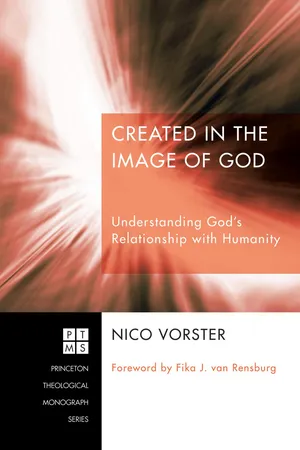1
Image of God
Introduction
Christian theological traditions almost without exception take the concept of the imago Dei as point of departure for its doctrine on the human being. However, there is little agreement amongst theologians on the precise content and meaning of the imago Dei. The human being’s image-bearing qualities have for instance been located in free will, intellectual and rational capacities, moral nature, self-consciousness and the immortal soul, emotional characteristics that distinguish persons from animals, a self-transcendent nature, outer appearance, being God’s representative on earth and a relationship with God. These different interpretations are mainly due to the fact that the Priestly creation narrative gives a vague definition of the human being as an image-bearer. The multivalented use of the concepts sIelem (reflection) and dĕmût (copy) especially leads to confusion and speculation. Old Testament scholars agree that the concept of the imago Dei only appears in the Priestly parts of Genesis 1–11, which is dated relatively late. According to some the imago Dei can therefore not be regarded as a central concept in the Old Testament.
However, the validity of this statement depends on the content ascribed to the concept. If the imago Dei is essentially understood as a description of the inherent characteristics of the human being, as postulated by Irenaeus, Philo and Gregorius, the concept is not of central importance in the Old Testament. If it is a relational concept that indicates the nature of the human being’s relationship with God, or if it indicates the way in which the human being represents God on earth, it can be stated with confidence that the imago Dei is of crucial importance for a theological anthropology. Towner rightly indicates that all biblical anthropology is ultimately theological anthropology that defines the human being in terms of his relationship to God. Although the reference to the human as image of God seldom appears in the Old Testament, the Old Testament understands the nature of the human being in terms of a relationship with God.
It should furthermore be kept in mind that systematic theology’s interest in the imago Dei is largely due to the Christological content that the New Testament ascribes to the concept. The New Testament authors agree with the Priestly narrative’s description of the status of the human, but they also expand the concept of the imago Dei by relating it to Christ and applying it eschatologically to the life of the church. According to Grenz the concept of the imago Dei is a key motive in New Testament Christology. The New Testament authors use it to explain God’s salvation-historical work in the human being from the beginning to the end. The dogma of the imago Dei therefore has important implications for a theological anthropology, hamartology and Christian understanding of salvation.
The purpose of this chapter is to provide an outline to a theological anthropology by focussing on the concept of the imago Dei. The central theoretical argument is that the Priestly narrative purposely ascribes an “open” meaning to the concept of the human being as image of God which makes further theological reflection possible. The imago Dei should therefore not only be understood from a protological perspective, but the Christological and eschatological content that the New Testament gives to the concept is crucial for the understanding of the concept and the development of a theological anthropology. At the same time the New Testamentical definition of the human’s image-bearing can not be properly understood without the protological foundation of the image-bearing in the Priestly narrative. One can never speak of the human being as image of God without taking note of God’s original aim with the creation of the human.
The Imago Dei in Protological Perspective
Genesis 1:26–28 offers different interpretative possibilities regarding the human’s image-bearing qualities. The image can be connected to the representation of God, based on Gen 1:26. The interchangeable use of dĕmût and sIelem makes it possible to qualify this representation as a reflection of God’s virtues (dĕmût) or to seek it in ontological and physical characteristics that the human shares with God (sIelem). Dĕmût appears in the Old Testament 21 times and comes from a Hebrew root that indicates reflection or copy. SIelem can be translated as likeness. The word is used 17 times in the Old Testament and mostly indicates physical representation.
The image-bearing can also, based on Gen 1:27, be linked to man’s creation as male and female. If verses 26 and 27 are read together, the image can be sought in the fact that the human, like God, simultaneously leads a singular and plural existence. It is furthermore possible, on the basis of verse 28, to understand the image as a combination of man’s creation as male and female and his mandate to rule over creation. Each of these possibilities have been followed in history.
Representative Views
Based on the words dĕmût and sIelem in Gen 1:26–28, Ireneaus distinguished between the human as image of God in a natural sense (imago) and a super-natural sense (similitudo). The imago then indicates the human’s natural capacity for ingenuity and freedom, while the similitudo indicates a super-natural likeness of God. According to Irenaeus the imago Dei suggests that it is the destination of the human being to ultimately become part of the divine nature. The problem with Irenaeus’ understanding is that it shows a strong Gnostic influence. His notion that the human is a physical image of God—or that the human can take part in the divine nature—is contrary to the anthropology of the Old Testament, which maintains a distinction between God and human beings. The prohibition that the Second Commandment places on depictions of God, as well as the Old Testament’s association of such activities with heathen practices, are clear indications of this.
Several Old Testament scholars follow Von Rad in explaining sIelem in terms of the ancient Near Eastern Imperial ideology. Von Rad states this theory as follows:
According to this vie...
